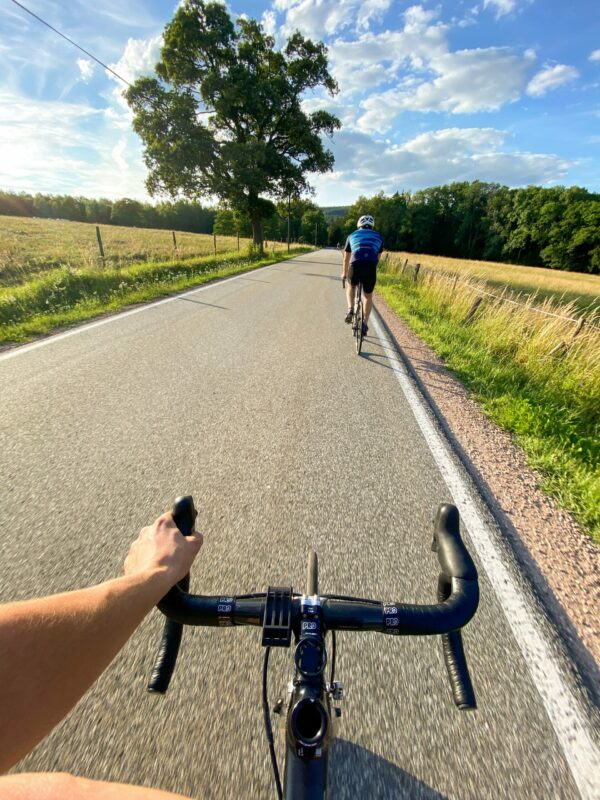Running a half marathon requires more than just running training. You must set yourself a realistic goal and take into account your normal daily life. It is a good idea to do an expectations survey both with yourself and with your surroundings. In Focusing on training for a half marathon with confidence, you have to consider if there are time and surplus for training several times a week.

What motivates you to line up for the race? Being able to reflect on goals and training is thus important and an underestimated and overlooked aspect of running training.
Let’s assume you’ve been through these basic aspects and have decided to run a half marathon in 8 – 16 weeks from today. Now you have to know some basic rules. to enhance your chances to be a successful runner
Train To A Half Marathon – The 4 Basic Rules
Start slowly
In the long run, you want to avoid injuries and achieve improvements faster if you are patient with increasing speed and distance. Do not increase your weekly distance by more than 5 -7% and less if you are a beginner. Gradually increase your pace training once you have built a low-intensity running basis. And It is not a good idea to increase both speed and distance at the same time.
Rest days
Your body needs to recover and rebuild itself after training. So, days of intensive or long training sessions should be followed by days of light training/running or rest so the body’s rebuilding processes have time to ‘do their job’.
Warm-up and Stretching
Warm-up is a great way to wake up the body both physically and mentally to be ready for the day’s training. In addition, you also reduce the risk of injury when your muscles are warmed up well before they have to perform. The muscles are short and tight until you start using them more than their current state. You should also start up with easy jogging and stretching exercises.
Be aware of injuries
Injuries only get worse if you try to run them away. If you have persistent pain, then rest and, if necessary, put an ice pack on the sore area as soon as possible and seek your own doctor, specialist or skilled professional. Do what you can to get rid of the damage. Prompt treatment will provide a faster recovery.
As you should understand is that respect for your body comes before everything else.
The vast majority of training programs also contain many different types of training, mostly because variation is extremely important to keep your motivation and increase strength and endurance and avoid the one-sidedness that running, in general, can be and therefore also easier can cause injuries.
Training Plan For Half Marathon
When you decide to start your training for a half marathon, there are some basic elements that should be included in your training plan. I have used them in various ‘mixing ratios’ for many years with success in my training plans. So let’s look at them below.

Lactate training: Fast runs at a speed on the limit of what you find comfortable. Is equivalent to about your half marathon pace. They usually last for 20 – 40 minutes. They can be divided into fast and slow sequences and teach the body to run fast for longer periods of time. Are also often used as test runs to test where you are in a given training course over the season.
Tempo/Interval training: Rapid repetitions put together with rest periods. e.g., 7 x 1000 m with 3-minute breaks. They improve strength, speed, and running economy and you do not have to be a fast runner to complete them.
Long Slow Distance (LSD): This is the cornerstone of marathon training. The key to building endurance. These runs are best done on weekends or free days. Long slow runs (LSD) can be extended to between 1 and 3 hours, depending on your goals and your shape. The time spent on running is more important than the speed.
Hill training: Pace training on hills with greater emphasis on strength and mobility. Run hard uphill, jog down and repeat. The variations of opportunities are endless – a typical workout can be 8 – 12 x 1 minute on a steep ascent.
Fartlek: Fartlek is a Swedish invention. A free form of pace training where you set the pace up on random intervals during normal running.
Cross Training Workouts

A good way to improve your fitness and minimize the risk of injury is to supplement your running training with other aerobic forms of workout exercises – called cross training. This could be cycling, swimming, strength and agility training. In addition to improving your fitness in general, they will also make you a better runner.
Several trainers claim that the way to run better is to run more, but most runners will benefit more from getting the best out of relatively shorter distances and then adding one or two good alternative forms of exercise per week.
You can use alternative training / supplementary training to replace a light running workout per week and there are definitely running workouts such as pace training and long slow runs that it does not make sense to replace with other supplemental activities.
But it can get boring and depressing in the long run to train the same thing over and over again. But it is up to you to assess what suits you best for your goal.
Warm Up And Cool Down Workout

To perform optimally during both training and competition, it is important to have good routines for warming up and cool down. Always start with a 10 – 15-minute warm-up and spend about the same amount of time for cool down as the end of a training session.
Injury prevention
Fiber injuries in the buttocks and calf muscles are well-known running injuries. With proper up and cool down, you will significantly minimize the risk of injuries. In the absence of heating, you will over time increase the risk of injury to muscles as well as tendons and joints. Lack of cool down can be the cause of stiff and sore muscles.
Physical preparation
The main purpose of warming up is to prepare your body for running. Body temperature, heart rate and respiratory rate rise. This causes your blood vessels to dilate and adds more oxygen to the muscles.
When heated, the risk of accumulation of waste substances such as lactic acid and ammonia is counteracted, which can give the experience of ‘burning muscles’.
The improved physical shape has a positive effect on the body’s biomechanics. As your body temperature rises, the flexibility of your shoulders, hips, knees and ankles increases, which will give you easier and more efficient running.
Improved performance
Warming up before training or a race will improve your performance, as the body will be ready from the start of the run. This readiness ensures that you can run with an appropriate technique and optimal speed. Cooldown is essential to achieve complete recovery before your next training session or run.
Mental preparation
You should prepare yourself mentally for training and running, as your mental state affects your physical abilities. A thorough warm-up is ideal to get you ready for training or running.
Free yourself from distracting thoughts. Increased focus will sharpen your attention so that you make the right choices on the route and dispose of your energies correctly, even when physical and mental fatigue sets in.
Running economy
Warming up will improve your running economy because your heart rate rises and your blood vessels dilate. This allows you to absorb more oxygen more efficiently in the muscles.
Cooldown is slow recovery runs and stretching exercises after training. It lowers your heart rate to the resting heart rate and reduces the risk of muscle soreness, so you become ready for the next training session ‘tomorrow’ faster.
Half Marathon Training Plan

As a runner, the main purpose of your training plan is to perform at a given time. To achieve the goal you have planned, you must have a structured training program consisting of several phases: a basic phase, a specific phase and a performance phase.
Set yourself a goal
Before you start, you must have a sense of how good your basic shape is at the moment and what you would like to achieve. First, you have to test your fitness by, for example, a cooper test.
Use the results from the test to set up a realistic SMART goal. It can be a running event or a half marathon. Then plan your training and find a program that suits you. Gradually try to become stronger and more enduring. This is often best done by running shorter distances and then increasing from here.
Build up your basic shape
With the right basic shape, you will be able to immediately proceed to greater challenges and minimize your risk of injuries. If you get an injury, it affects you not only physically but also mentally.
The purpose of the basic phase is to build endurance, improve your running economy and generally get your body used to running more. Your basic phase should include various types of running with increasing speed, fartlek and long runs. In addition to this, the basic phase should include days of cross-training.
You can supplement your workout which will improve your muscle strength. An effective basic phase not only helps you to become a better runner but will also reduce your risk of injuries.
Focus on increasing your strength and endurance toward your planned goal. This can be done by continuing to do cross-training, but more important are your choices of different forms of running for running training.
The different types of running such as long runs, pace runs and interval runs are all great for building your running strength.
You should also consider the terrain in which your running event will take place and train specifically for this purpose. e.g., you should train in hilly terrain in this phase if the race you have chosen as a goal contains inclines.
Performance training
Training is about performing. But the performance phase of your training program is also about optimizing your strength and endurance, so you can meet your goals.
This is achieved by combining the different forms of running, short and long runs, speed runs and interval runs to suit your goal. You can perform these training sessions in the last weeks up to the race or as part of the ‘downsizing’.
But remember if you have not built up a solid basic form and developed this in the specific phase, then you will not get the maximum out of the training in the performance phase.
Restitution
Once you have completed a race, you must recover, the longer you have run – the longer break you need. After a race, it is a good idea to take a break. as a rule of thumb, you should take a break one day per 5 km you have run.
Listen to your body. Everyone has different needs for restitution. In order not to lose your aerobic capacity, it is obvious to do cross-training in the form of swimming, cycling or yoga. Cross-training allows you to train, while your running muscles are allowed to recover.
Half Marathon Training Schedule
To prepare and complete a half marathon, you have to see it as a project where you create a frame and fill it out with the most important elements. The aim is how to train for a half marathon and successfully Complete it.
Training programs follow logical steps, but the programs can be developed from different basic principles. So you have to research a little to find the best fit for your purpose by running a half marathon. You can also start here to understand a frame plan- and develop a personal running program.

Finally, it’s recommended that you test your shoes and clothes during your training sessions. Never run a race in brand new shoes. It is also important that you run in shoes that aren’t too old and worn out, and that your shoes fit your running style and running technique.
That is why you always have to test running shoes when you buy new ones. In addition, you should also test your clothes so you know what works best for you. In that way, you can avoid injuries such as blisters and joint marks. Click on the image above end to get one of the best running marks on the market – excellent for half marathon training.
Final Thoughts
There are so many benefits to running a half marathon. Just to mention a few here:
It may be that the body complains a little the first few times, but once it gets used to it, it will be eternally grateful to you. There are countless health benefits to running.
Running is effective circuit training. It strengthens the heart, lowers blood pressure and reduces the risk of blood clots and cardiac arrest.
Running is effective circuit training – and many other things. It strengthens the heart, lowers blood pressure and reduces the risk of blood clots and cardiac arrest.
But the best benefit as I see it is to participate with thousands of other ‘like-minded’ like being part of a large event working towards a common goal and being part of a large community and of course it is not so difficult as a full marathon, more people have the opportunity complete without difficulties.
I hope you like this blog and if you have any questions about the topic or want to leave your own Personal review, please leave a comment below.
[faq-schema id=”3885″]










You have encouraged me to give this half marathon thing a try! Running a half-marathon is not bad for us if we adequately train for a half marathon and have no underlying medical conditions. Getting a nod of approval from a licensed medical professional is in also important. So I will go check my doctor.
Hi Abel
Thank you for the comment. Good pointe with a medical check before getting started.
Be Well
While it is good to enjoy the great outdoors by getting involved in this type of activity that is so beneficial to one’s health there are certain ways to go about this in order to get the most out of it. It is possible to train for this kind of event with confidence by following this guide that you have laid out. Thanks so much for sharing.
Hi Norman
Thank you for the comment. happy that you can use some of it. I agree that training – especially running is beneficial for one’s health.
Be Well
Hello, I love your website It’s got some real good information on how to train for a race. And it looks great!!
Hi there
thanks for an interesting post.
I agree that we should start an exercise programme with a goal in mind.
I like the way you talk about building up the basic form and then talk about specific and performance training. You also mention the importance of resting and preventing injuries.
A great tip about running shoes and outfits and the importance of wearing them in so as not to find out on a race day that they are uncomfortable.
there are so many benefits to running.
Best wishes
Sheen
Hi Sheen
Thank you for the comment. Happy that you could use some of the tips. Yes with a goal in mind, you have made a priority and know what to focus on.
Be Well